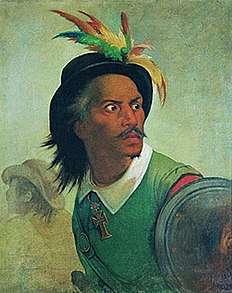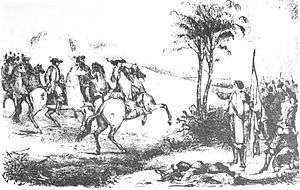Second Battle of Guararapes
The Second Battle of Guararapes was the second and decisive battle in a conflict called Pernambucana Insurrection, between Dutch and Portuguese forces in February 1649 at Jaboatão dos Guararapes in the Brazilian state of Pernambuco. The defeat convinced the Dutch "that the Portuguese were formidable opponents, something which they had hitherto refused to concede."[8] The Dutch still retained a presence in Brazil until 1654 and a treaty signed in 1661.[9]
| Battle of Guararapes | |||||||
|---|---|---|---|---|---|---|---|
| Part of Dutch-Portuguese War | |||||||
The Battle of Guararapes by Victor Meirelles, painted 1878 | |||||||
| |||||||
| Belligerents | |||||||
|
|
| ||||||
| Commanders and leaders | |||||||
|
|
| ||||||
| Strength | |||||||
| 3,500[3] | 2,600[4] | ||||||
| Casualties and losses | |||||||
| 1,045 dead, wounded or captured[5] |
45 killed[6] 200 wounded[7] | ||||||
History
Though the Dutch West India Company fielded a larger, better equipped force, they suffered morale problems as most of their army was made up of mercenaries from Europe (primarily Germany) who felt no real passion for the war in Brazil, as opposed to the Natives and Portuguese settlers who considered Brazil to be their home and were fighting for a patriotic cause. The Dutch force was also unused to fighting in the dense jungle and humid conditions of the country, wearing thick, brightly coloured European clothing and heavy metal armour which inhibited their dexterity. Contemporary accounts describe Dutch troops at the battle as "pale and sickly". The Dutch army at Guararapes were armed with pikes, cannon and an assortment of bladed weapons. It is thought by historians that the use of short blades by the Dutch was an attempt to imitate previously successful Portuguese weaponry and tactics.
The Portuguese force was made up of an assortment of natives, blacks and whites who knew, and had experience fighting in, the difficult Brazilian terrain. They weakened Dutch troops with fusillades of musketfire from behind trees, and then charge with mêlée weapons.
The Dutch had expected the enemy to march down the well established coastal roads, and thus formed a line of defence covering these roads. However, the Portuguese force used a series of minor trails to reach Pernambuco, appearing out of the wetlands to the west and Guararapes Hills (from which the battle derived its name) and flanking the Dutch. After several hours of fighting, the Dutch retreated northwards to Recife, leaving their artillery behind. Following the Dutch retreat, the Portuguese army marched into Pernambuco.
An eyewitness account of the Dutch defeat by Michiel van Goch written a few days after the battle notes
The enemy's men [the Portuguese forces] are naturally agile and surefooted, able to advance or retreat speedily. They are also formidable from their natural ferocity, consisting as they do of Brazilians, Tapuyas, Negroes, Mamelucos, etc., all natives of this country; as also Portuguese and Italians, whose constitution enables them to adapt themselves very readily to the terrain, so that they can range the woods, cross the swamps, and climb or descend the hills (all of which natural obstacles are very numerous here), and that with remarkable speed and agility. Our [Dutch] men, on the contrary, fight ranged in serried ranks, after the manner of the fatherland, and they are sluggish and flabby, unsuited to this kind of country.[10]
With the defeats of the Dutch in the two battles, albeit narrow ones, opinion in Amsterdam considered that "Dutch Brazil by now no longer had a future worth fighting for," which "effectively sealed the fate of the colony."[11]
The participation of Afro-Brazilian Henrique Dias[12] and indigenous leader Filipe Camarão resulted in their receiving honors from the Portuguese crown.
Depictions in art

Antwerp painter Gillis Peeters painted an image of the battle in 1650, showing the rocky landscape and combat between Dutch soldiers armed with rifled and stereotypical Amerindians with bows and arrows.[13] Nineteenth-century Brazilian painter Victor Meirelles produced a vivid image of the battle as well as a portrait of Filipe Camarão, as Brazil claimed its role in defeating the Dutch. A painting depicting the Battle of Guararapes is located in the lower choir of the Church of Our Lady of the Conception of the Military in Recife.[14]
Important participants
- Henrique Dias - Son of slaves, he was the governador da gente preta (governor of the black people), ex-slaves from farms reached by the conflict.
- Filipe Camarão - Native Brazilian from the Potiguar tribe, leader of the forces from that tribe.

- João Fernandes Vieira - Land owner from Funchal, Madeira, commanded one infantry terço.
- André Vidal de Negreiros - Commander of one infantry terço.
See also
Further reading
- Araújo, Hugo André Flores Fernandes. "Amigos fingidos y enemigos encubiertos: el gobierno general y la insurrección pernambucana (1642-1645)." Prohistoria 21 (2014): 27-53.
- Boxer, Charles R., The Dutch in Brazil, 1624-1654. Oxford: The Clarendon Press 1957.
- Cabral de Mello, Evaldo. 'Olinda Restaurada: Guerra e Açúcar no Nordeste, 1630-1654. São Paulo: Editora da Universidade de São Paulo 1975.
- Groesen, Michiel van. Amsterdam's Atlantic: Print Culture and the Making of Dutch Brazil. Philadelphia: University of Pennsylvania Press 2017.
- Marley, David, Wars of the Americas: a chronology of armed conflict in the New World, 1492 to the present (1998) ISBN 978-0-87436-837-6
- History of Portuguese America, in Portuguese, by Sebastião da Rocha Pita
Notes
- David Marley, p.133
- David Marley, Brincks army's disintegrates, the commander himself falling mortally wounded. p.133
- David Marley, Some 3,500 Dutch troops march out of Recife under Colonel Brinck (...) p.133
- David Marley, (...) confronting 2,600 Portuguese defenders under Governor Barreto dug in on the Guararapes Plain. p.133
- David Marley, Dutch losses total 1045 dead, wounded or captured (...) p.133
- David Marley, (...) 45 Portuguese killed and 200 wounded. p.133
- David Marley, p.133
- Charles R. Boxer, The Dutch in Brazil, 1624-1654. Oxford: The Clarendon Press 1957, p. 215.
- Francis A. Dutra, "Dutch in Colonial Brazil" in Encyclopedia of Latin American History and Culture, vol. 2, p. 419. New York: Charles Scribner's Sons 1996.
- quoted in Boxer, Dutch in Brazil, pp. 215-16.
- Michiel van Groesen, Amsterdam's Atlantic: Print Culture and the Making of Dutch Brazil. Philadelphia: University of Pennsylvania Press 2017, p. 127.
- Judith L. Allen, "Henrique Dias" in Encyclopedia of Latin American History and Culture, vol. 2, p. 375. Charles Scribner's Sons 1996.
- Van Groesen, Amsterdam's Atlantic, pp. 150-51. The image is on page 151.
- Menezes, José Luiz Mota (2013). "Church of Our Lady of the Conception of the Military". Heritage of Portuguese Influence/Património de Influência Portuguesa. Retrieved 2017-05-08.
![]()